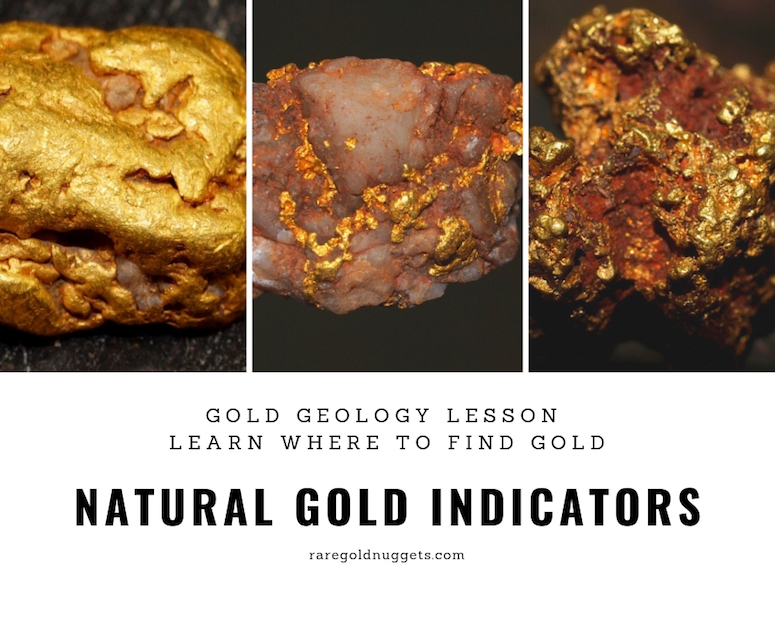
Gold Geology and the Natural Indicators that can help you find gold
Not all gold deposits out there have been found and mined. There are still places that contain gold that have never been worked, despite the fact that miners have been searching for gold for hundreds of years now. If you can find one of these undiscovered gold deposits you have a good chance that you have found something special, since you will have been the first person to mine it. To find one of these deposits, you need to be able to identify the natural indicators that will lead you to finding the gold.
Learn the Geology of your Mining District
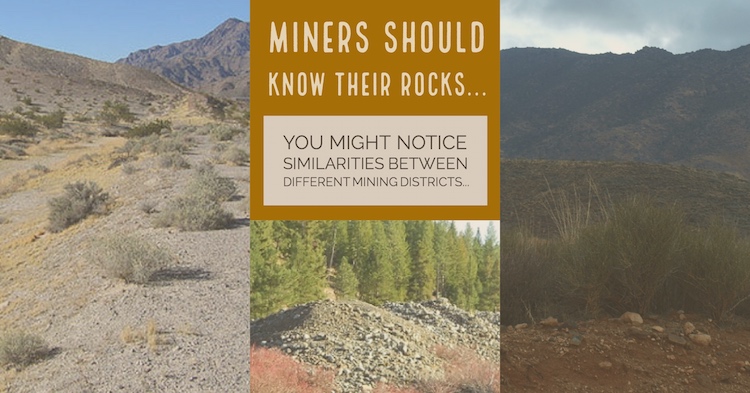
It is extremely important to learn about the geology of your particular mining district. All areas are different, and you need to understand what to look for in the specific area that you are searching for gold. There are certain things that are common to all gold districts, but understanding exactly where and how gold is found in the particular district that you are searching is extremely important.
Productive Rock Types for the Area
When researching a mining district, good gold geology references will indicate the general rock types that area associated with the productive gold mines in the area. Pay attention to these most common rock types and always be looking for them when you are out prospecting. They can be an indicator of where gold will occur.
The general rock type alone is generally not a great indicator or where to search, since it is probably common once you are within a known gold district, but it is one of many things that are worth considering.
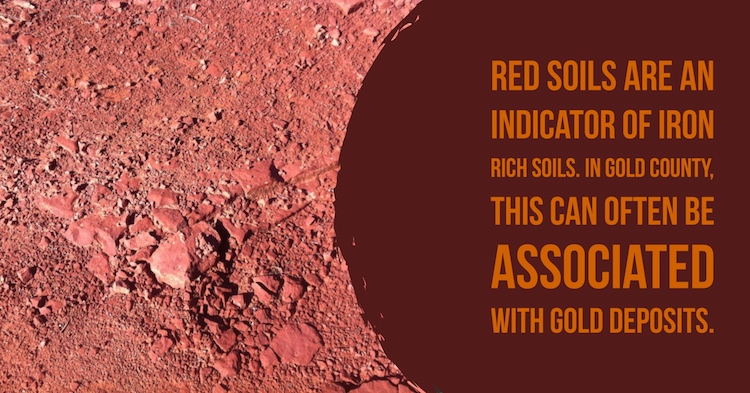
Probably just as important to identifying the country rocks associated with gold is being able to identify the host rocks that are generally not associated with gold. If your research has never indicated that gold occurs within a certain rock type, then you certainly don’t want to spend a significant amount of time searching within that type of geology.
Geological Contact Zones
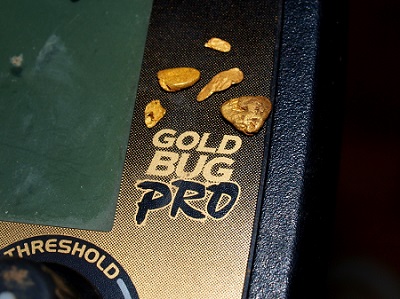
Several nice gold nuggets found in an afternoon of metal detecting. This location was at least 1/4 mile from the nearest historic”diggings,” but careful study of the surrounding rock types meant that there was a good likelihood that there was more gold to be found…
Your research will often indicate with rock types are going to be the most productive from a gold prospecting perspective, but the most important thing is that there is a contact. Often the rock types are irrelevant, as gold seems to occur in all different types. What is most important is that some type of contact occurred, which created pressure and often extremely high temperatures which caused fissures to form and gold to be pushed up to the surface.
An entire book could be written on the subject of contact points and gold formations. To keep it simple, I will just say that identifying these areas were different rock types came together are often extremely important.
The general trend of the geology within your district is very important. Look for contact points where different rock types come together at a 90 degree angle. These contacts resulted in high pressure and high temperature conditions that would commonly produce gold. You will find that many of these areas will have some historic workings, there are still areas out there that are “textbook” contact zones that are very rich with gold that have never been mined.
Also Read: Find a Secret Gold Prospecting Spot – These Research Tips Will Help…
And: 15 Metal Detectors That Will Find Gold Nuggets
And: Where to Look for Gold in Rivers & Creeks
Gold Geology and Ground Color Changes
Color changes in the soil are another indicator of a contact point. Depending on how much bedrock is exposed in an area, you may or may not be able to easily identify contact points where different rock types come together, but you will be able to see where soil color changes. Since soil is composed of the host rock, even a small change in soil color can be an excellent indicator of a contact zone.
Some color changes can be very readily apparent, while others can be quite subtle. You aren’t looking for small areas with minor change here, you want to try and identify distinct lines of different soil types.
These contact zones may be generally short, but sometimes they will run in a generally straight line for many miles. You may also have success finding new gold bearing areas by locating productive mines and then noting a color change that extends off from the mine. There may be valuable gold deposits in a nearby drainage that are an extension of the same contact zone that occurs at a well-known mine just over the hill.
Remember to always study the different types of gold geology and you will soon learn that there are plenty of areas that have not yet been found.
Iron Staining ~ Hematite ~ Magnetite ~ Black Sands
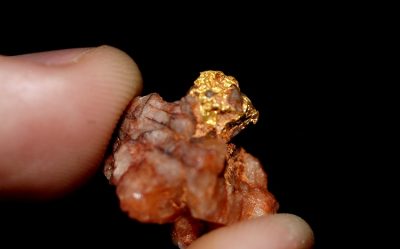
Notice the reddish staining on this gold/quartz specimen. It was found in an area with deep reddish/purple colored soils, mixed with scattered bits of quartz on the surface. This gold in this piece is probably worth around $25 or so…
You will also find that most of the areas that you can find gold nuggets with a metal detector also have high iron content.
This is easily visible by the presence of very dark soils. They are often black or reddish in color, but they can even show purple, orange, yellow, and a variety of different colors. These dark or brightly colored soils can be an indicator of high iron content, as well as many other minerals associated with gold.
This is the reason that it is recommended that you use metal detectors specifically designed for detecting gold nuggets, since they are specifically designed to handle these highly mineralized, iron-rich environments.
Quartz
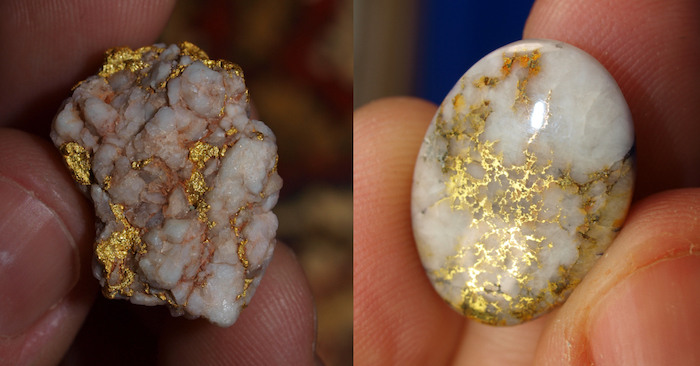
Veins of gold run throughout this quartz. The piece on the left is in its raw, natural form. The piece on the right is also natural, but it has been cut and polished into a cabochon for use in jewelry.
Most people know about the common association of gold with quartz. Gold veins often form within quartz rock and it is certainly an indicator to look for. However, many prospectors give more attention to quartz than it really deserves.
Quartz is the second most abundant mineral on the Earth’s surface, and it can be found in many locations that have very little or no gold. Thus, the presence of quartz by itself is a fairly poor indicator of the potential for gold.
While the presence of quartz alone is not a very good indicator of where gold can be found, there is no doubt that there are many gold districts where gold and quartz have a strong correlation.
I generally consider quartz to be a good indicator once I know that I am in a known gold bearing area, and I have identified that there is a relationship between gold and quartz in that particular area.
Let me explain that a bit more for clarification. There are some gold bearing areas where gold and quartz are commonly found together. Many times the gold nuggets that are found will have a very coarse texture and still have quartz attached to them down in the grooves of the nugget. This indicates that they were eroded directly from the quartz. In these areas, it is worthwhile to spend some time metal detecting around quartz outcroppings and scanning quartz pieces with your detector.
However, there are many areas that you can find gold nuggets that seem to have little to no association with quartz. There may be quartz present in the area simply because it is so common, but the gold doesn’t run through the quartz itself, it is just there.
Research is yet again a good way to determine the value of quartz as an indicator in an area. Mining reports will often mention if gold veins occur in the quartz.
Another thing worth noting about the quartz is that the kind of quartz that gold is generally found in is not pure white. Most commonly it will show significant iron staining, and the quartz will have a dirty appearance with reddish/brown stains. Gold can be found in pure white quartz, but it is much rarer, and highly collectable.
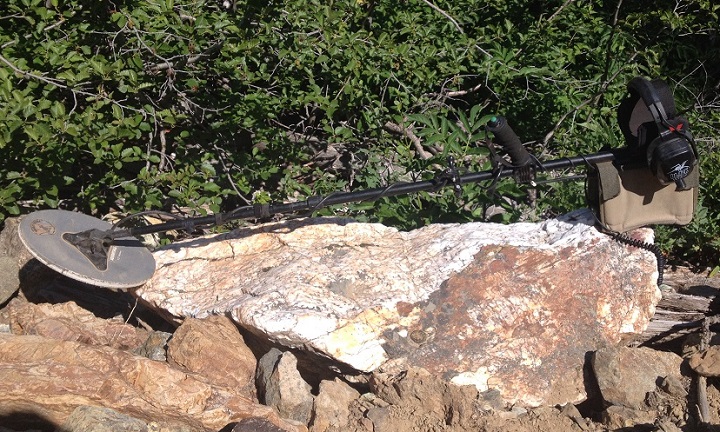
A huge chunky of white quartz in some old mine tailings. It can be a great indicator that an area may have gold.
Similar Appearances to Nearby Gold Districts
One of the best ways to find new, undiscovered gold deposits is to study the geology of known gold districts and then explore the fringes of that known district. Identify areas that have a similar geological appearance.
We are not discussing any specific indicator here. This could be one or several natural indicators that are similar to a gold district with a known history of gold production. This is one of the best ways to find an area that nobody has ever prospected before, but it can take a lot of time and patience, and you will likely spend a lot of time searching before you stumble upon any gold.
Read: Finding Spots that were Missed by the Early Gold Miners
Bench Deposits
Bench deposits are locations near the current river channel that have been left “high and dry” as the river has eroded and moved over time. Some rivers are constantly moving and changing their path. Some rivers that are deeply entrenched in bedrock really don’t move much, but many rivers that have a wider, meandering path will change location frequently with each high water event. These changes may be as small as a few feet or sometimes they are hundreds of feet. When this happens, rich placer deposits can get “left behind” by the river, and remain in place away from the current river channel.
Bench deposits also occur as a river naturally erodes downward. In these cases, a layer of gold bearing gravel will often be found just a few feet above the current high water mark of the river.
The great thing about bench deposits is how often they are overlooked by other prospectors. It seems that most placer miners are focused on the water’s edge, and don’t take the time to look around and study the river. Even in areas that have been prospected hard over the years, and finding a nugget down near the water can be difficult, bench deposits are often left nearly untouched.
Ancient River Channels
Somewhat similar to bench deposits, the presence of ancient river channels is something that many prospectors completely overlook, or don’t even know about. The exciting thing about locating ancient rivers is that they are sometime virtually unknown and may have never been searched with metal detectors.
So what is an ancient river? Imagine for a moment that it we are in the Jurassic time period, approximately 200 million years ago. A rich gold bearing river is flowing; a river that has never been prospected and has been completely untouched by man. It has millions of ounces of gold within its gravel.
As the years go by, the Earth changes in dramatic ways. Tectonic plates come together and create the mountains that now exist across the western United States. Some areas that were once valley bottoms are now located high up on the side of a mountain.
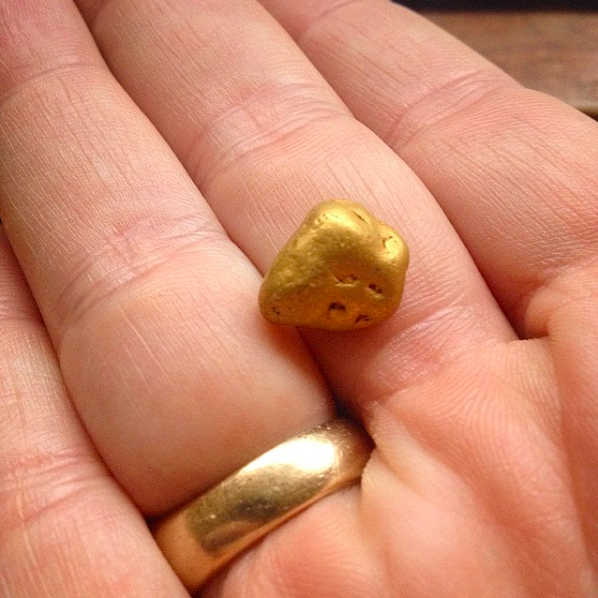
This big 1/4 ounce nugget was found with a metal detector in an ancient river channel. You can see by its thick, smooth appearance that it was tumbled and polished smooth, even though it has been millions of years since it’s been in a river.
Many people have a hard time grasping the concept of how much the Earth can change over millions of years, but it most certainly has. There are ancient rivers that were once full of water and rich with gold that are now found high above the existing water line. Of course they no longer contain water, but the ancient river channel (and gold) remains.
Identifying an ancient river channel is actually quite simple once you know what to look for. Think about how different a water worn rock looks compared to the average rock that you find on the side of a mountain. The smooth, polished look of gravel within a river channel really doesn’t chance much, even after millions of years.
If you notice round, river worn rocks and gravel away from a current waterway, ask yourself “How did it get there?”
Again, studying old mining reports may provide some insight on where ancient river channels may be found. When in doubt, strap on your hiking boots and start exploring!
Next: Prospecting for Gold Ore – Techniques to Find Rocks with Gold







